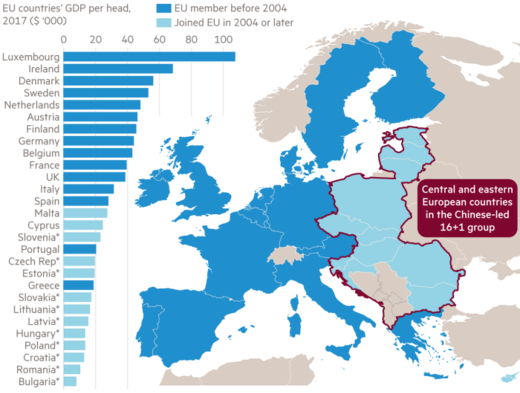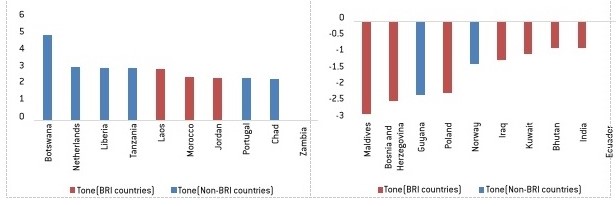International Institute for Middle East and Balkan Studies (IFIMES)[1] from Ljubljana, Slovenia, regularly analyses developments in the Middle East, Balkans and also around the world. Maria Smotrytskais a senior research sinologist, specialized in the investment policy of China. In her comprehensive analysis entitled “Belt and Road in the Central and Eastern EU and non-EU Europe: Obstacles, Sentiments, Challenges” she describes the place and significance of the CEE region in the Chinese Belt and Road Initiative.

International Politics & Economics specialist
Today at a broader diplomatic and strategic level, the BRI has become a symbol of China's growing importance in international affairs, changing regional dynamics in geographical areas close to or even within Europe. At the most basic level, the strategic implications of expanding China's policy in the EU stem not so much from a set of projects with a single link, but from its comprehensive nature.
China-related initiatives, such as the AIIB and the BRI, – it is ample clear – have already changed the global financial development landscape. Similarly, in the sphere of security relations, there is a need to protect assets and citizens abroad leading to the “securitization” of Chinese BRI participation abroad, which is likely to significantly change China's role in the regions of European interests. Within Europe, and in conjunction with sub–regional “mini-initiatives” in China, such as CEE 16 + 1, the BRI also contributes to changes in the policy-making landscape in Europe and China.
When analyzing China's relations with CEE countries in the framework of the BRI initiative, it should be noted that the initiative was put forward with the principle of mutual complementarity of economies, taking into account the differences between China and neighboring countries, as well as taking into account all existing shortcomings in the infrastructure of all prospective participants in this economic project. Such complementarity provides an important basis for long-term business cooperation between China and neighboring countries, and even the creation of the Eurasian Union could not affect the complementarity of the economic systems of China and neighboring countries, because only in the process of joint efforts to create the “Silk Road Economic belt” will it be possible to fully overcome the underdevelopment of infrastructure in this region.
The Chinese government emphasizes that the “One belt, One road” initiative “complements” existing national and European plans (for example, the so-called “Junker plan” or plans promoted by individual EU member States) to develop infrastructure and expand connectivity in Europe and beyond. Most of the ambassadors in European countries note the importance of the BRI and its significance for the development of relations between China and European countries.
Analyzing the role of CEE countries in the implementation of the Chinese “One belt, one road” initiative, it can be noted that the specifics of the region's countries are the potential for market development and geographical advantages. An important role is played by projects to create continental and maritime transport routes that can transport goods between China and Europe. In developing cooperation, first of all, it is necessary to focus on market requirements, follow the principle of “first simple – then complex”, avoid political risks, give enterprises a guiding role and take into account the leading role of important projects.
It should also be underlined that in the format of the initiative, there are equal partnerships between all countries, it does not have strict mechanisms, and its structure allows for multi-level, multi-layered cooperation that covers all areas of collaboration, including politics, economy and humanitarian exchanges. This multi-functional format is useful for promoting bilateral relations between China and the CEE countries, and it can also play a stimulating role in the development of China – Europe relations. At the same time, when building ties between within the 16 + 1 format and China – EU cooperation, a number of questions arise that cause concern in the EU government circles about the role played by the PRC in the region.
Today the CEE region is located at the junction of the “Economic Belt of the New Silk Road” and the “Maritime Silk Road of the 21st century”. Both routes connecting the markets of Europe and Asia – sea and land-pass through it; it performs an important function of ensuring the passage of commodity flows. The CEE region has the advantage of location; through it, cargo is sent overland from Western China via Russia or Central Asia to Western Europe. China gains a strategic advantage from redistributing some of its Maritime supplies, reducing the use of the Strait of Malacca. In addition, there are commercial considerations: in terms of time, this overland route speeds up transportation twice as compared to the usual way of delivery by sea with reloading to the railway, and at a price it is much more profitable than air transportation.
The sea route from China to the Greek port of Piraeus for the delivery of goods to the Balkan Peninsula, which lies at the intersection of transit communications in Europe, Asia and Africa, has great prospects. Currently, 80% of cargo from China to Europe goes through the Atlantic Ocean to the ports of Northern Europe. The sea route through the Arabian sea and the Suez Canal to the Balkans will reduce the transport time by 7 – 10 days: this is the shortest sea route from China to Europe. However, to do this, CEE needs to build transport infrastructure, which the region has a huge need for. This is especially true for the Balkan Peninsula, which has entered a period of stable development after riots and wars that caused serious damage to infrastructure.
The membership of 11 of the 16 CEE countries in the EU is an advantage that provides “system guarantees” EU members and candidates comply with European laws and standards, which reduces the risks for Chinese investment in infrastructure projects. According to the researcher, continuing economic growth and expanding market demand make the CEE region an ideal “target market”. Thus, political stability has bring results, and in the first decade of the XXI century many Central and Eastern European countries have gone from “transition countries” to European representatives of “new markets”. This is not only a transport corridor on the way to the core of traditional Europe, but also an increasingly important investment and consumer market in itself. It is attractive because the laws there are European, but land and labour are cheaper than in Western Europe.
Based on the analysis of China – CEE relations, it can be seen that cooperation between China, the EU and CEE countries can also contribute to the balanced development of Europe. The bilateral ties between China and CEE for 70 years have laid a solid Foundation for cooperation in the 16 + 1 format. The relationship is now entering a new era of multilateral cooperation that is not focused on a single European sub-region, but reflects Trans-regional characteristics. Thus, when analyzing the relations between China and the countries of the region, we should not limit ourselves to the regional level, but we should go to the Trans-regional and global scale.
For example, the 16 + 1 initiative is an inter-regional cooperation in which China focuses on linking its efforts with those of Europe and considers rail links, ports and foreign direct investment as the basis for ensuring balanced development and social cohesion in European countries. For example, the construction of a railway between Hungary and Serbia was far more important for both countries than obtaining short-term economic benefits. It is part of an Express route connecting land and sea from the port of Piraeus across the Balkan Peninsula to the main corridor in Europe. In the future, the Express route will be extended to cover new areas near the three seas that wash the coasts of the CEE countries.
However, the economic relations between China and the CEE countries are still underdeveloped, - as one of the most influential institutes from Eastern Europe, the Balkan-based IFIMES (International Institute for Middle East and Balkan Studies) of Ljubljana constantly argues: “Sino-Balkans relations have a great future due to the fact that China is one of the most important investors in Europe“. Thus, it is worth noting that before the start of cooperation in the 16 + 1 format, Chinese investment and trade were not spatially balanced and were concentrated in the North – Western part of Europe. Due to the poorly developed transport infrastructure, trade between China and the CEE countries was carried out through the ports and railways of Germany, Holland and France.
More importantly, China has begun to develop cooperation with Central and Eastern European countries in the field of innovation. This is a very promising direction. At the summit in Dubrovnik in 2019, China and the CEE countries expressed the idea of building a bridge as a sign of strengthening cooperation between China and the EU, which would reflect the great potential of China and Eastern European countries as partners with the same level of development.
The projects that China is able to offer are thought out comprehensively and can be effectively implemented with the participation of state corporations. They will help countries like Croatia achieve their goals faster and more effectively. In short, the 16 + 1 Initiative will help transform this region from a marginal region of Europe to a link between Europe and China.
Cooperation in the 16 + 1 format is sub-regional in nature, but the PPI will help it become a Trans-regional way of developing connectivity on land, in the air, in the ocean, and on the Internet. Now even North Africa and the Middle East can become part of this interface. Its results will be systemic in nature.
The goal of China's cooperation with Central and Eastern European countries is not to continue to use CEE countries as a trade route, but to combine the industrial development needs of these countries with China's large production capacity, using the potential of Central and Eastern European countries in the Chinese market. If Chinese products are close to the Central European market, it is necessary to ensure the presence of high-tech products from CEE countries in the Chinese markets.
Cooperation between China and CEE countries should reflect the future development trends. The interface includes not only traditional modes of transport, energy, labour and capital, but also digital infrastructure and data flows based on new technologies. There are huge opportunities for expanding cooperation between China, the 5G industry and service businesses. Cooperation with China is also intended to contribute to the economic revival of the Balkan region, the implementation of Internet and smart city projects. Small countries can play the role of connecting links between China and Europe.
However, despite the positive aspect of the development of relations between China and CEE countries within the framework of the BRI initiative, they also continue to face new challenges and problems.
Thus, according to the researcher, China, as a towering large state, should pay attention to not taking a position and not making statements that can give rise to security concerns and distrust in the CEE countries.
Map 1.: China`s 16+1 grouping built around EU`s newer, poorer members

Source: IMF, FT research
Thus there is an urgent need to upgrade the rail infrastructure in Belarus and Ukraine, which caters for transit traffic to and from the EU. And also conflicting views appeared on whether and how Chinese parties, and particularly contractors, would adapt to, and comply with, EU standards in areas such as construction.
A related concern was that weak legislation in rail transit countries might permit environmental damage. The EU cannot impose higher standards on the construction or operation of railways in non-EU states such as Russia and Kazakhstan. There are, however, a number of mechanisms by which the EU can encourage higher standards:
-through the terms and conditions of EU involvement in financing or supporting infrastructure projects;
-through the supply of products compliant with (high) EU environmental standards; and
-through operating, or encouraging other parties to operate, through rail services using locomotives and other equipment with a high environmental performance.
An institutional stakeholder made the point that EU standards could always be imposed and, in principle, enforced if a project was funded by the EU, but that this was less likely to be possible if the same project was funded by China.
10. One of the challenges, which cause the emergence of many contradictory and negative opinions about the Chinese initiative in European political and business circles is primarily due to Europe's low awareness of the project, its main goals and structure. Thus, analysis found that the BRI is generally positively perceived, but differences are marked at the country level with some countries having negative perceptions.
Figure 1.: Media sentiment for most positive countries
Figure 2.: Media sentiment for most negative countries

Source: Bruegel based on https://www.gdeltproject.org/
Figure 1 and Figure 2 above further report the countries with the most positive and negative sentiments towards the BRI. The first impression is that Europe and Asia both extremes of positivity and negativity. That means China`s initiative has particularly penetrated the two regions, but is evaluated very differently by different countries and regions.
Within Europe, BRI members tend to have a much worse view of China`s initiative (especially Bosnia and by Poland), compared to others, especially the Netherlands. Thus, China does not seem to be necessarily improving its image through efforts made under the auspices of the BRI projects or, at least, not when the way it is perceived in non-BRI countries. It is increasingly perceived by many on both sides of Atlantic as “opaque, imitative, assertive and ‘suddenly’ omnipresent” – as prof. Anis H. Bajrektarevic detailed in his luminary work ‘The post-C-19 epilogue of Sino-American relationship’.
Thus, as a result of the analysis of China – CEE relations in the framework of the BRI project, it can be concluded that there are both positive trends and possible challenges in China – CEE relations and their role in China's relations with the EU.
While the specific impact of the “integrity” of the BRI on European territory is still limited, new transport corridors are already emerging, and their frequency of use is growing rapidly. One is a rail link between China and Western Europe via Poland to Germany and beyond; the other is a North – North corridor between Greece and the Baltic region through Central Europe, and Piraeus as a fast–growing centre in the Mediterranean, and actors in Italy are involved in expanding their profile as part of an expanding South – North logistics network. At the same time, cooperation with third countries (Ukraine, Russia, and Belarus) remains at very early stages, as the degree of readiness of European companies to participate in Chinese-led infrastructure projects outside Europe remains unclear.
The article describes the place and significance of the CEE region in the Chinese Belt and Road Initiative. Drawing on the basics of Sino – European political and economic cooperation and mutual infrastructural projects within BRI, author emphasized that initially focused on involving into the Chinese initiative the European countries, along with opportunities, has faced a whole range of legislative, economic and infrastructure challenges.
Key words: BRI, CEE, Central and East Europe, China, 16+1, challenges, risks
About the author:
Maria Smotrytskais a senior research sinologist, specialized in the investment policy of China; BRI-related initiatives; Sino - European ties, etc. She is distinguished member of the Ukrainian Association of Sinologists. She has PhD in International politics, Central China Normal University (Wuhan, Hubei province, PR China)
Ljubljana/Shanghai, 20 September 2020
Footnotes:
[1] IFIMES – International Institute for Middle East and Balkan Studies, based in Ljubljana, Slovenia, has Special Consultative status at ECOSOC/UN, New York, since 2018.